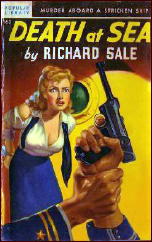Sun 15 Jul 2012
RICHARD SALE – Death at Sea. Popular Library #163; paperback original; 1st US printing, 1948. First published in the UK as Destination Unknown: World’s Work, hardcover, 1940.

That there were eight years between when this book was published in England and when it finally came out in the US is an interesting fact, and there may even be a story behind it. Or perhaps not. Even more likely, we may never know, but the passage of time certainly affected the immediate relevance of the story, which takes place in 1940 on a Dutch freighter in the Caribbean, a ship that also takes on passengers.
What’s significant here is the year, 1940, and Nazi agents are everywhere – and something they may have their eyes on is the S. S. Apeldoorn. On board is a passenger named Gabriel Adams, an ichthyologist by trade, and as a brief side trip on his way to a conference in Brazil, he stops to pick up a rarity, a modern-day specimen of a fish long since believed to be extinct.
Getting back to the ship, though, all of the other passengers have cancelled, and two members of the ship’s crew were replaced at the last minute before the voyage by two others, neither of who are known to the captain. Signs of dangerous waters on the horizon?
There are, not too surprisingly, a couple of good-looking women involved. Richard Sale didn’t spend most of the 1930 writing thrillers like this for the pulp magazines for nothing. Adams proves himself to be more than an expert on fish when he sees through the first one’s wiles almost immediately, but he’s saved in the nick of time by the second when she claims to be his wife when the first follows up by attempting to pull a version of the old badger game on him. (Perhaps I ought to start taking Caribbean cruises. Such things have never happened to me by staying on dry land.)
The first half of this sea-going adventure is far better than the second. Once the mystery of what is going on is resolved, about half way through, everything falls into place rather sedately, figuratively speaking.
But here is a portion of the story as it appears on page 125. I could hear the voices of two rather famous movie stars in the roles, and perhaps you can, too. (Merrill is the second of the two ladies mentioned above. Setting: The pirates have just taken over the ship.)
She was sitting coolly on the edge of one of the tables, a little pale, but without a sign of terror or hysteria. She was smoking a cigarette and she did not run to him and throw her arms around him and start crying. She just said:
“Hello, Gabriel. Come to hear the high council?â€
She took his hand and squeezed it hard and smiled crookedly at him. Her eyes were far away.
“Yes,†Gabriel said nonchalantly, and it was genuine nonchalance for he was too tired to give a damn at that point. “You were lucky to get a change of clothes. I’m still in this monkey suit.â€
“We were told to be quiet,†Merrill said. “You mustn’t talk so loudly. See the gentleman with a gun?â€
Gabriel saw him. It was another of the German lads, Leiper this time, and he looked ugly.